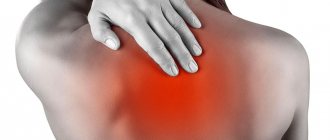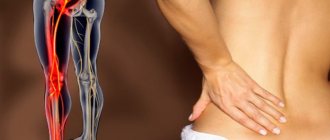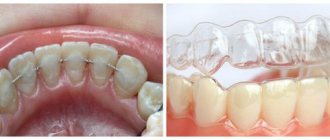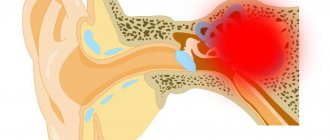Pain between the shoulder blades is not a typical location for back pain. As a rule, if your back hurts, then it hurts in the lumbar region or some specific vertebrae.
But compression, burning or pulsation in the upper back between the shoulder blades can cause confusion - such a problem is not heard and is rarely discussed. Therefore, a person who is faced with a similar situation searches on the Internet for answers to the questions “Why does my back hurt in the area of the shoulder blades? Which doctor should I consult for back pain between the shoulder blades? And how to treat pain in the shoulder blade?”
In just 6 minutes you will learn a lot more information on this topic and will know how to act in such a situation.
Pain in the shoulder blades: what could be the causes?
The average person is well aware of what the scapula is - a flat triangular paired bone in the upper back. But why does it hurt?
The most likely reasons could be:
- Spinal problems, injuries. Poor posture, curvature of the spinal column, and osteochondrosis lead to compression of nerve endings and the occurrence of pain symptoms.
- Diseases of the internal organs: pneumonia (pneumonia), pleurisy, angina pectoris, pericarditis, gastritis and gastric perforation due to ulcers are accompanied by severe pain in the upper back.
- Muscle problems: myalgia, muscle inflammation (myositis) cause nagging pain in the shoulder blades.
Why does my back hurt in the shoulder blade area? In addition to the above, pregnant women may experience pain in the shoulder blades at different stages, which is normal for them. But the problem can be more serious - neoplasms (both benign and malignant) in the chest or abdominal cavity can give similar symptoms. However, do not rush to panic and sound the alarm - even stress can indirectly lead to pain in the shoulder blades due to muscle strain and stooping. Such symptoms can be caused by excess weight, poor posture at work or while sleeping.
Types of pain between the shoulder blades
The symptom itself - that is, the nature of the pain in the shoulder blades - says a lot about the underlying disease. Pain can be acute, paroxysmal or chronic (constant), and it also varies in type and intensity.
Aching pain in the shoulder blade
In most cases, aching pain between the shoulder blades indicates pathology of the vertebrae and spine. Scoliotic deformities of the spinal column, osteochondrosis or herniated disc cause such symptoms. A peptic ulcer can also manifest itself as aching pain - in this case, you cannot do without a gastroenterologist.
Burning in the area of the shoulder blades
The occurrence of burning pain in the shoulder blades tells us about potential heart problems, for example, coronary heart disease. Such pain does not depend on movement, rarely lasts long and goes away soon after taking nitroglycerin. The second option is pinching of the nerve by intervertebral discs. Nitroglycerin will not help here, but non-steroidal anti-inflammatory drugs will help. Relief comes if you change your body position to a more comfortable one. In addition to the above, a burning symptom occurs when gastric contents reflux into the esophagus (reflux esophagitis).
Dull pain between the shoulder blades
As a rule, patients describe the pain that occurs due to pathology of tendons, ligaments and muscles with the word “dull.” The same characteristic is given to painful sensations in diseases of internal organs - cholecystitis or cholelithiasis.
Throbbing pain in the shoulder blade
Injury to the ribs, shoulder blades or vertebrae provokes the appearance of characteristic throbbing pain in the area of the shoulder blades. These painful symptoms may become more pronounced when sneezing or coughing. You should not hesitate to deal with such symptoms - you need to quickly contact a traumatologist.
Pressing pain in the shoulder blade
With inflammation in the muscles surrounding the scapula, a feeling of compression may occur. In addition to severe pain, myositis (inflammation of the muscle) leads to limited mobility of the shoulder and arm.
Sharp, sharp pain between the shoulder blades
An incipient stomach ulcer, an attack of biliary colic or pyelonephritis is manifested by a stabbing, sharp pain. In case of perforation of the ulcer, the pain begins in the stomach, accompanied by nausea, heartburn and bloating. With pleurisy, the patient will also notice a sharp pain in the area of the shoulder blades, but it will be complemented by a cough.
Pain when inhaling
If pain appears or intensifies during inhalation, this may signal us about lung disease or intercostal neuralgia. The pain with neuralgia has a shooting, encircling character. And with lung diseases, as a rule, the pain is accompanied by a cough, poor general health, weakness and fever.
Whatever the nature of the pain between the shoulder blades, if it does not subside within 1-1.5 days, it is recommended to visit a doctor.
Which doctor should I consult for back pain between the shoulder blades?
Since the etiology of pain between the shoulder blades is quite varied, the first thing you need to do is make an appointment with a therapist. The doctor will assess the situation, collect anamnesis, conduct an initial diagnostic examination and advise which specialist to contact for the most effective relief from pain in this localization.
Further treatment can be carried out by a traumatologist, orthopedist, neurologist, gastroenterologist, cardiologist, pulmonologist and other highly specialized specialists.
How is pain in the shoulder blades diagnosed?
In addition to collecting complaints, examining and carefully palpating (feeling) the causative area, the doctor may need to carry out a number of additional diagnostic measures:
- General and biochemical blood test, urine test.
- X-ray examination (if a deeper study is necessary, computed tomography (CT)).
- Magnetic resonance imaging (MRI) to assess the condition of internal organs, ligaments, tendons.
- Ultrasound diagnostics may be useful in determining kidney and bowel function.
- Electrocardiogram for diagnosing heart disease.
- Fluorography for suspected pulmonary problems.
- Gastroscopy to study the function of the stomach.
Back pain between the shoulder blades: treatment methods
How to relieve pain under the right shoulder blade
If pain in the scapula area is associated with diseases of the spine, muscles or injury, then painkillers should be taken as first aid. For this purpose, non-steroidal anti-inflammatory drugs or NSAIDs are most often used. They effectively fight pain of any origin, suppressing inflammatory reactions. However, uncontrolled and long-term use of NSAIDs increases the risk of side effects of this group of drugs, such as stomach ulcers, gastric bleeding or kidney failure. Therefore, without a doctor’s prescription, it is permissible to take analgesics for no more than 5 days, after which you must consult a doctor for diagnosis and treatment.
Local remedies in the form of distracting and analgesic ointments, gels and patches do not have such side effects, since this dosage form is limited to the area of application. They help especially well with myositis, muscle strain, attacks of neuralgia and other diseases with chronic pain syndrome. In diseases of the spine, pain can be relieved by rest, limiting physical activity and prohibiting heavy lifting.
It is strictly forbidden to use painkillers if you suspect acute cholecystitis, pancreatitis and other diseases of the abdominal organs that require emergency surgery. Taking painkillers in such patients can lead to temporary relief of symptoms and a false sense of improvement, which ultimately contributes to late presentation and serious condition of the patient due to extensive inflammation of the peritoneum or peritonitis.
If pain in the area of the shoulder blade on the right occurs against the background of severe abdominal pain, accompanied by fever, nausea, and vomiting, you must seek medical help as quickly as possible.
Shpidonov Gennady Stanislavovich
Neurologist
Rostov State Medical University (neurology)
10 years of experience
Treatment of pain between the shoulder blades
After reading this article, you understand that pain in the shoulder blades can be a sign of very different diseases. If you do not suffer from any chronic illness and are experiencing pain between the shoulder blades for the first time, then you can try to approach treatment symptomatically. First of all, make sure that you are not in a constant state of muscle tension due to an uncomfortable posture while sleeping or working. You can take a painkiller 1-2 times. However, if this does not help, you should no longer delay visiting the doctor.
How to relieve pain in the shoulder blades
When pain comes on suddenly and is disabling, the best thing you can do is try to relieve the pain. Taking analgesics (Nimesulide, Ibuprofen, Ketorolac) will temporarily relieve pain. You can apply an ointment with the same active ingredients to the painful area of the back.
We do not recommend massage or self-massage in such cases. We also do not recommend using any warming compresses or warming your back in any other way. All this can only make the problem worse.
How to treat shoulder blade pain
Treatment of the disease that provoked the symptom in the form of pain between the shoulder blades should be carried out by a doctor of the appropriate specialty. This can be a very serious pathology, and its treatment must be treated carefully. We will not delve into cardiology and gastroenterology, but will talk about restorative and restorative procedures that will be useful for any possible disease.
- Physiotherapy . In the rehabilitation of a patient after diseases of the spinal column and joints, a gradual return of the body to physical activity plays a huge role. Of course, this should not happen during an acute period of illness, when every movement is difficult. However, during the recovery stage, physical therapy and therapeutic exercises have a positive effect on the condition of the whole body by strengthening muscles and working out joints.
- Kinesiotherapy. For quick and functional recovery after injuries and diseases of the supporting system, kinesiotherapy is prescribed. This set of exercises with your own weight or with specialized simulators gently and without overloading the body helps restore the former mobility to damaged joints. In addition, the stimulating effect of kinesiotherapy on immunity and metabolism has been proven. Regular exercise can slow down the transition of the disease to the chronic stage and prevent relapse of the disease.
- Massotherapy. The beneficial effects of massage are difficult to overestimate. In addition to the physiological effect on the body, stroking and kneading muscles also have an effect on a person’s psychological state. And by stimulating blood circulation and metabolism, recovery occurs faster and more harmoniously.
- Acupuncture. An experienced acupuncturist is able to influence special points (acupuncture points), stimulating the body's internal reserves to fight the disease. The indications for the use of acupuncture are so wide that it is difficult to name a disease for which it would be ineffective. This is an effective way to get rid of pain, muscle tension and spasms. According to research, acupuncture in combination with other physiotherapeutic procedures can reduce the duration of treatment.
At the KANO physical therapy clinic in Minsk, we offer you the experience of our specialists, which they have collected and implemented in the “Healthy Back” rehabilitation program, thanks to which you can move again without pain and do what you love, or simply forget about the problem that has haunted you a lot years.
Read also
Clubfoot
Clubfoot should not be understood as just one foot disorder.
This is a group of deformities of the foot and ankle joint with their pathological setting. Clubfoot is a deformity in which… Read more
Amyotrophy
The word atrophy, translated from Latin, means loss or decrease in the volume of muscle mass or an individual muscle. Most often, muscle atrophy occurs due to limitation of active movements, for example, after...
More details
Neuropathy
In the human body, the work of internal organs and systems is regulated by the brain, namely by nerve impulses emanating from it. These impulses travel along nerve fibers. Damage to them can damage this...
More details
Arnold-Chiari malformation
Due to the availability of the study and the high resolution of MRI, we quite often come across the conclusion - Arnold-Chiari anomaly. What is meant by this concept? Arnold-Chiari malformation...
More details
Polyneuropathy
Diabetic polyneuropathy is a pressing problem for patients with diabetes. Diabetic polyneuropathy is a serious complication of diabetes mellitus. The incidence of polyneuropathy is 26-50%...
More details
Diagnosis of causes
If pain occurs under the shoulder blade on the right and persists for a long time, you should definitely consult a doctor. If you cannot independently determine from the existing symptoms which specialist you should make an appointment with, you should consult a therapist.
The doctor will evaluate the patient’s complaints and conduct an examination, the results of which will allow him to exclude a number of pathologies that can cause discomfort under the right shoulder blade. If necessary, he will definitely prescribe a series of laboratory and instrumental tests that will help establish the causes of pain and refer the patient to the specialist he needs: a neurologist, nephrologist, gastroenterologist, etc.
In the future, the patient may also be asked to undergo an examination, on the basis of which a specialist doctor will be able to make the correct diagnosis, assess the degree of pathological changes and select the optimal treatment. To diagnose the causes of pain under the right shoulder blade, the following are used:
- X-ray or CT scan of the spine - allows you to assess the condition of the vertebrae, their position, which makes it possible to diagnose scoliosis, kyphosis, and scapula injuries;
- MRI of the spine – used to diagnose pathologies of intervertebral discs and soft tissue structures;
- Ultrasound of the abdominal cavity - allows you to evaluate the size, shape, structure of the liver, pancreas, gall bladder.











